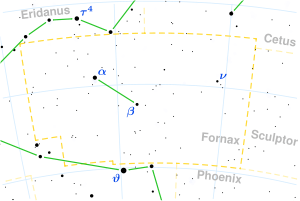Gamma2 Fornacis
Gamma2 Fornacis (γ2 For) is a star in the constellation Fornax, with an apparent magnitude of 5.4. It is an A1 main sequence star 2.4 times as massive as the Sun and 120 times as luminous. Gamma1 Fornacis is a 6th magnitude star four degrees to the north.
 | |
| Observation data Epoch J2000.0 Equinox J2000.0 (ICRS) | |
|---|---|
| Constellation | Fornax |
| Right ascension | 02h 49m 54.1822s[1] |
| Declination | −27° 56′ 31.123″[1] |
| Apparent magnitude (V) | 5.377[2] |
| Characteristics | |
| Spectral type | A1 V[3] |
| Astrometry | |
| Radial velocity (Rv) | 24.0±4.2[4] km/s |
| Proper motion (μ) | RA: −47.053±0.247[1] mas/yr Dec.: 20.932±0.258[1] mas/yr |
| Parallax (π) | 6.3134 ± 0.1330[1] mas |
| Distance | 520 ± 10 ly (158 ± 3 pc) |
| Absolute magnitude (MV) | −0.35[5] |
| Details | |
| Mass | 2.4[6] M☉ |
| Radius | 4.5[7] R☉ |
| Luminosity | 120[7] L☉ |
| Surface gravity (log g) | 3.5[6] cgs |
| Temperature | 9,000[6] K |
| Metallicity [Fe/H] | −0.02[8] dex |
| Rotational velocity (v sin i) | 149[9] km/s |
| Age | 401[6] Myr |
| Other designations | |
| Database references | |
| SIMBAD | data |
γ2 Fornacis is about 520 ly from Earth and is receding at 24 km/s. Comparison of its properties to theoretical models suggest an age of about 400 million years.
References
- Brown, A. G. A.; et al. (Gaia collaboration) (August 2018). "Gaia Data Release 2: Summary of the contents and survey properties". Astronomy & Astrophysics. 616. A1. arXiv:1804.09365. Bibcode:2018A&A...616A...1G. doi:10.1051/0004-6361/201833051. Gaia DR2 record for this source at VizieR.
- Høg, E.; Fabricius, C.; Makarov, V. V.; Urban, S.; Corbin, T.; Wycoff, G.; Bastian, U.; Schwekendiek, P.; Wicenec, A. (2000). "The Tycho-2 catalogue of the 2.5 million brightest stars". Astronomy and Astrophysics. 355: L27. Bibcode:2000A&A...355L..27H.
- Houk, N. (1982). Michigan Catalogue of Two-dimensional Spectral Types for the HD stars. Volume_3. Declinations -40_ƒ0 to -26_ƒ0. Bibcode:1982mcts.book.....H.
- Gontcharov, G. A. (2006). "Pulkovo Compilation of Radial Velocities for 35 495 Hipparcos stars in a common system". Astronomy Letters. 32 (11): 759–771. arXiv:1606.08053. Bibcode:2006AstL...32..759G. doi:10.1134/S1063773706110065.
- Anderson, E.; Francis, Ch. (2012). "XHIP: An extended hipparcos compilation". Astronomy Letters. 38 (5): 331. arXiv:1108.4971. Bibcode:2012AstL...38..331A. doi:10.1134/S1063773712050015.
- Gullikson, Kevin; Kraus, Adam; Dodson-Robinson, Sarah (2016). "The Close Companion Mass-ratio Distribution of Intermediate-mass Stars". The Astronomical Journal. 152 (2): 40. arXiv:1604.06456. Bibcode:2016AJ....152...40G. doi:10.3847/0004-6256/152/2/40.
- McDonald, I.; Zijlstra, A. A.; Watson, R. A. (2017). "Fundamental parameters and infrared excesses of Tycho-Gaia stars". Monthly Notices of the Royal Astronomical Society. 471 (1): 770. arXiv:1706.02208. Bibcode:2017MNRAS.471..770M. doi:10.1093/mnras/stx1433.
- Anders, F.; Khalatyan, A.; Chiappini, C.; Queiroz, A. B.; Santiago, B. X.; Jordi, C.; Girardi, L.; Brown, A. G. A.; Matijevič, G.; Monari, G.; Cantat-Gaudin, T.; Weiler, M.; Khan, S.; Miglio, A.; Carrillo, I.; Romero-Gómez, M.; Minchev, I.; De Jong, R. S.; Antoja, T.; Ramos, P.; Steinmetz, M.; Enke, H. (2019). "Photo-astrometric distances, extinctions, and astrophysical parameters for Gaia DR2 stars brighter than G = 18". Astronomy and Astrophysics. 628: A94. arXiv:1904.11302. Bibcode:2019A&A...628A..94A. doi:10.1051/0004-6361/201935765.
- Zorec, J.; Royer, F. (2012). "Rotational velocities of A-type stars. IV. Evolution of rotational velocities". Astronomy and Astrophysics. 537: A120. arXiv:1201.2052. Bibcode:2012A&A...537A.120Z. doi:10.1051/0004-6361/201117691.
This article is issued from Wikipedia. The text is licensed under Creative Commons - Attribution - Sharealike. Additional terms may apply for the media files.